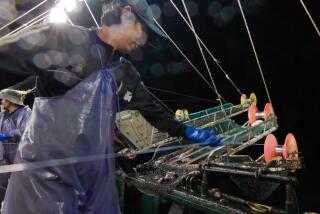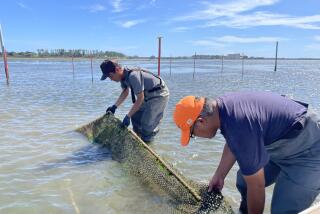Fish Farms Grow Into Major Food Source
NEW YORK — The hot dog you eat at a ballgame in coming years may be made from a fish you’d never consider eating now, and you’ll warm it up by pulling a tab on the wrapping, some food futurists say.
Whether or not the International Food Futurists’ predictions come to pass, Americans are eating more fish: an increase from 12 pounds per person a year to 15.9 pounds per person a year over the last decade.
A forum held by the futurists and funded by the Norwegian Salmon Marketing Council predicts that by the year 2020, Americans each will eat about 25 pounds of seafood a year. That will spur use of species of fish we don’t now eat and an expansion of fish farming, or aquaculture, according to trade groups and producers.
Other predictions:
- An increase in prepackaged, preportioned items, boned or shelled by factory robots. Much seafood will be bought frozen.
- Seafood will be used to make hot dogs and “ham” and increasingly eaten as a snack.
- Species of seafood will be altered to grow faster from fertilized egg to market size, and hybrid species will carry the best characteristics of two kinds of seafood.
- Packaging will enable consumers to pull a tab to heat a precooked dish without using an oven.
Among the successful aquaculture projects in this country are catfish, spurred by a taste for Cajun cooking, and coho salmon raised in cages in the Northwest.
And the United States already imports much of its shrimp from farms in Ecuador and China, said John Liston, who chaired a National Academy of Sciences committee that recently looked at seafood safety.
Worldwide, fin fish and seafood are farmed in 50 countries. The food futurists’ report predicted that more species will be raised, including turbot, black sea bass and swordfish. Norway, an aquaculture pioneer, expects to begin shipping farm-raised halibut to the United States by 1995.
Liston’s committee emphasized the need to clean water and improve waste treatment to preserve fishing areas. It also called for creation of an effective inspection program for imported fish. It found no significant problems with current aquaculture operations, he said.
“Theoretically, aquaculture might provide us with a method for eliminating a lot of these hazards,” Liston said.
But he said it also could present other problems, such as the use in other countries of drugs that keep the fish disease-free but show up as residues in food. And fish farming done in a natural environment could still subject the fish to any pollution upstream, said Liston, professor emeritus at the Institute for Food Science and Technology at the University of Washington in Seattle.
Liston said he expects a substantial expansion in aquaculture, but he added: “I don’t think we’re up against . . . the necessity to depend on aquaculture for our supplies.”
The commercial supply is “probably as safe as any food,” Liston said, but he told consumers to be wary of shellfish that is not well-cooked and of any fish a friend brings home from a trip.
The use of seafood analogs also is likely to increase, specialists say.
Manufacturers expect per capita surimi consumption to grow from the current half a pound a year to 1 1/2 pounds a year by the end of decade, said Allison Wheeler of the National Fishers Institute in Arlington, Va. Surimi is reconstituted fish paste that can take many forms such as imitation crab or lobster.
But such analogs are unlikely to tempt chefs’ palates.
Charlie Trotter of Charlie Trotter’s Restaurant in Chicago said he is pleased at the prospects of increased availability and selection of fin fish and seafood, but called surimi “appalling.”
“I don’t endorse the constructing of food,” he said.
More to Read
Sign up for Essential California
The most important California stories and recommendations in your inbox every morning.
You may occasionally receive promotional content from the Los Angeles Times.











